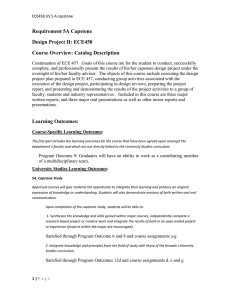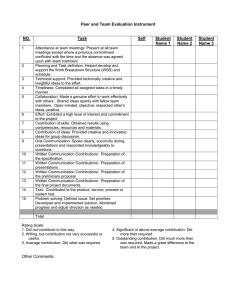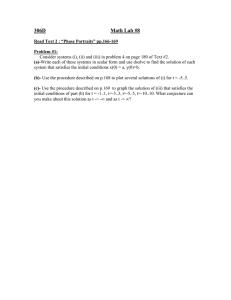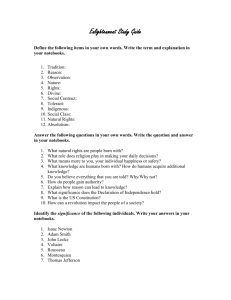Requirement 5B, engaged learning Design Project I: ECE457 Course Overview: Catalog Description:
advertisement
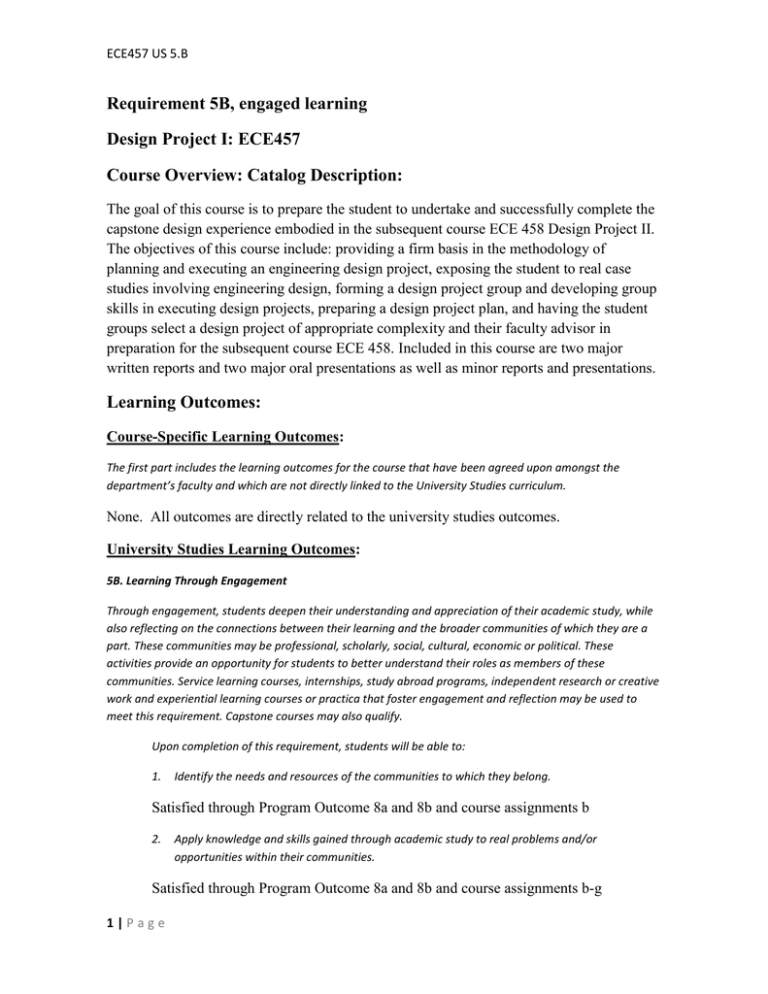
ECE457 US 5.B Requirement 5B, engaged learning Design Project I: ECE457 Course Overview: Catalog Description: The goal of this course is to prepare the student to undertake and successfully complete the capstone design experience embodied in the subsequent course ECE 458 Design Project II. The objectives of this course include: providing a firm basis in the methodology of planning and executing an engineering design project, exposing the student to real case studies involving engineering design, forming a design project group and developing group skills in executing design projects, preparing a design project plan, and having the student groups select a design project of appropriate complexity and their faculty advisor in preparation for the subsequent course ECE 458. Included in this course are two major written reports and two major oral presentations as well as minor reports and presentations. Learning Outcomes: Course-Specific Learning Outcomes: The first part includes the learning outcomes for the course that have been agreed upon amongst the department’s faculty and which are not directly linked to the University Studies curriculum. None. All outcomes are directly related to the university studies outcomes. University Studies Learning Outcomes: 5B. Learning Through Engagement Through engagement, students deepen their understanding and appreciation of their academic study, while also reflecting on the connections between their learning and the broader communities of which they are a part. These communities may be professional, scholarly, social, cultural, economic or political. These activities provide an opportunity for students to better understand their roles as members of these communities. Service learning courses, internships, study abroad programs, independent research or creative work and experiential learning courses or practica that foster engagement and reflection may be used to meet this requirement. Capstone courses may also qualify. Upon completion of this requirement, students will be able to: 1. Identify the needs and resources of the communities to which they belong. Satisfied through Program Outcome 8a and 8b and course assignments b 2. Apply knowledge and skills gained through academic study to real problems and/or opportunities within their communities. Satisfied through Program Outcome 8a and 8b and course assignments b-g 1|Page ECE457 US 5.B 3. Describe the connections between learning on campus and the issues and needs of broader academic, professional or civic communities. Satisfied through Program Outcome 8a, 8b, 10a, 10b, 11, 12a, 12b, 12d, and 12e and course assignments a, b, c, and e 4. Articulate the value of engagement to other members of their communities. Satisfied through Program Outcome 9, 12a, 12b, 12d, and 12e and course assignments b, c, e and h ECE Department ELE and CPE Program Outcomes Program Outcome 8: Graduates will be able to design a system, component, process or computer program to meet design needs using design principles, techniques and engineering tools. a) Design Issues such as reliability, practicality, cost and meeting specifications b) Process Methods such as planning, progress reviews, reporting, scheduling Program Outcome 9: Graduates will have an ability to work as a contributing member of a multidisciplinary team. Program Outcome 10: Graduates will be able to communicate and express ideas coherently, professionally and effectively. a) Orally b) Written Program Outcome 11: Graduates will have an understanding of professional and ethical responsibility. Program Outcome 12: Graduates will have an understanding of contemporary issues and an understanding of engineering on society a) Global awareness b) Diversity d) Impact of engineering solutions e) Role of professional societies Examples of Texts and/or Assigned Readings: Design for Electrical and Computer Engineers: Theory, Concepts, and Practice, by Ralph M. Ford and Chris S. Coulston, published by McGraw-Hill, ISBN 978-0-07-338035-3 Course reading are listed in the course outline section 2|Page ECE457 US 5.B Example Assignments and Requirements: a) Resume (written description of their skills week 1) Satisfies Program Outcome 10b and US 5.B.3 b) System Requirements Review (oral presentation and written report week 7) Satisfies Program Outcome 8a, 10a, 10b, 11, 12a, 12b, 12d and US 5.B.1, 5.B.2 c) Project Plan (written report week 12) Satisfies Program Outcome 8a and 8b and US 5.B.1, 5.B.2, d) Acceptance Test Plan (ATP) (written report week 14) Satisfies Program Outcome 8a, 10a, 10b and US 5.B.1 and 5.B.2 e) Preliminary Design Review (PDR) oral presentation and written report (week 14) Satisfies Program Outcome 8a, 10a, 10b and US 5.B.1, 5.B.2, f) Preliminary Bill of Materials (BoM) (written report week 14) Satisfies Program Outcome 8a, 10b and US 5.B.2 g) Project Notebooks (one per student) (week 14) Satisfies Program Outcome 8a, 10b and US 5.B.2 h) Engagement essay (one per student) (week 14) Satisfies US 5.B.4 b) System Requirements Review The SRR will be used to assess whether or not you will produce a system that will satisfy the customer’s needs. The SRR will cover your understanding of the stakeholders needs and agreed-to requirements and specifications. Based on this understanding, you will address each of the following 13 criteria—1) technical performance; 2) functionality; 3) energy; 4) economics; 5) environmental; 6) health and safety; 7) legal; 8) maintainability; 9) manufacturability; 10) operational; 11) social, cultural and political; 12) usability; and 13) ethics—as it pertains to the possible designs options. You need to analyze and identify risks associated with each of your options. Note, you need not have selected one solution at this point in time. Deliverables: PowerPoint presentation and a short report. c) Project Plan 1) Requirements and needs: a. Customer needs and requirements (including performance, accuracy, power, weight, thermal, environmental and safety requirements) as given are to be analyzed for conflicts and assigned priorities. Specifications will be developed for all requirements. b. Requirements derived from the design approach selected are to be included in this section. 3|Page ECE457 US 5.B 2) 3) 4) 5) 6) c. Both customer and derived requirements can be system requirements or project requirements. Both are to be addressed. Task statements (TS), statement of work (SOW), work breakdown structure (WBS) and task responsibility matrix (TRM): a. TS/SOW: Describe tasks to be accomplished b. WBS: Task breakdown (what tasks are necessary to accomplish your project) in a hierarchical format c. TRM: Hours and person for each task in the task breakdown. d. Team process guidelines Technical approach: a. Explain the three design options. Explain and justify your preferred solution. As a minimum, include a functional block diagram and software structure breakdown of the system of the preferred solution. b. Include interface requirements (as known), including operator controls and displays c. Include a requirements traceability “matrix.” Schedule: a. Show all tasks with start and end dates, including reviews, presentations, and report dates. b. Students will create effort logs (time sheets) and update them a weekly basis. The effort logs would then be used to update the schedule on a regular basis to insure that the project is on track. c. Schedule will be given using a Gantt chart. Budget a. Present three budgets: one for actual cost, one for a production cost (actual cost + donations), and the third that adds a labor cost of $10.00 hour to the production cost. b. Student labor costs will be included in the budget (using data from effort logs and the WBS) c. Budgets will include G&A costs, indirect costs and fringe benefits. Risk analysis: a. Risk analysis will include the likelihood, potential impact, and mitigation strategy for three categories of risk: 1) technical performance risk, 2) schedule risk, and 3) cost risk. b. Identify areas that will benefit from prototyping (hardware and/or software) and explain how you will conduct these design efforts. The Project Plan is a living document and might need modification during the course of the project, therefore a mechanism for formally amending it is required. Specifically, the party requesting the change will write a brief description of the desired change, and all other parties will assess the impact on the design. These parties will respond, in writing stating that there is no impact on performance, cost or schedule, or specify the anticipated impact. Any changes must be approved in writing by all parties. (Students, course coordinator, faculty advisor, and customer, if applicable.) Deliverables: Electronic and paper copies. 4|Page ECE457 US 5.B d) Acceptance Test Plan (ATP) The ATP is a detailed document describing the step-by-step procedure to be used during acceptance testing, along with the expected results for each test. It is basically a 4-column document, where each column, left to right, contains: a) Requirement to be demonstrated b) Criteria (expected value) c) Step-by-step procedure d) Results (actual value) – to be completed during acceptance testing For each requirement, there may be many criteria, or values. And, for each value, there may be many steps to the procedure for measuring that value. The procedure must include any required test equipment and its settings for each test. A properly done requirements analysis provides the material needed for a) and b) above. A complete design provides the material required for c) above. The Acceptance Test Plan is a living document and might need modification during the course of the project, therefore a mechanism for formally amending it is required. Specifically, the party requesting the change will write a brief description of the desired change, and all other parties will assess the impact on the design. These parties will respond, in writing stating that there is no impact on performance, cost or schedule, or specify the anticipated impact. Any changes must be approved in writing by all parties. (Students, course coordinator, faculty advisor, and customer, if applicable.) Deliverables: Electronic and paper copies e) Preliminary Design Review The PDR will be used to assess whether or not your design has matured to the point where you can begin ordering parts. You are expected to justify your design choice and clearly explain expected risks, including a risk mitigation strategy that includes prototyping where appropriate. Additionally, the PRD will update all of the material you covered in the SRR (requirements, high level technical design, work breakdown structure, budget and schedule.) Deliverables: PowerPoint presentation and a short report. f) Preliminary Bill of Materials (BOM) Each project team should have a top level hardware block diagram and preliminary bill of materials (BoM). In addition, a list of required hardware and software tools should be generated to insure that the tools are available or can be procured by the department, especially in regard to departmental budget and lead time in procurement. Deliverables: Electronic and paper copies g) Project Notebooks Lab notebooks will be maintained in ink by each student. Notebooks will be bound (no spiral or ring-type binders) with the front of each page numbered in ink. There should be no erasures (cross out unwanted entries) and all entries (or pages) should be dated. 5|Page ECE457 US 5.B The notebook is not a diary; it is a method for documenting your engineering process. That is: goal idea research design prototype test analysis goal… Specifically include problems, analysis, design consideration and problem resolution or approach, results of builds, test plans. Include all requirements, design decisions (with rationale for each) all calculations, preliminary designs, test set-ups, and test results. You should also include the results of research you conducted. Do not copy specs for the sake of filling up space, but cite the relevant material and explain its importance in your design. There is generally no need to copy specs into the notebook, but if you must include data sheets and other material, they must be glued into these books so that they cannot be removed. Work that represents group effort will be documented as such, with a clear accountability of who was responsible for each piece. These are due with the formal report. Notebooks must be signed and dated at least every two weeks by your advisor. Effort logs must be permanently inserted into the notebook in proper chronological placement. h) Engagement You are write a one-page essay on "The value of engagement to other members of the community.” Report on how things have changed from doing canned labs in prerequisite courses to actually working (being engaged) with a customer, and how has this better prepared you as an engineer. Sample Course Outline: Week 1 2 Topic Intro Resumes Hear about projects Announce team leaders Ford book References Ch. 1 EIA/ANSI 632 Ch. 2 and 3 IEEE Std 1233, IEEE Std 8301998 Resumes due 3 4 5 6 6|Page Select teams & projects Systems approach Design Process Project organization Design notebooks Requirements development Discuss SRR Oral presentations MBTI intro Leadership and management MBTI assessment Team operations Ch. 12 Ch. 9 MBTI ECE457 US 5.B 7 SRR Presentations Team Operations Plan 8 9 10 Design option selected 11 12 Project Plan Due 13 14 PDR Presentations Preliminary BoM Notebooks collected ATP due Engagement assignment due 7|Page SRR Presentations Concept generalization “3 design options” Systems engineering Discuss Project Plan Statement of work (SOW), Work breakdown structure (WBS), Task responsibility matrix (TRM); Effort logs; Cost and schedule analysis; Earned value analysis (EVA) Bread-boarding, brassboarding, prototyping and risk reduction Acceptance testing & ATP Discuss PDR Detailed design and testing Bill of Materials (BoM) PDR presentations Ch. 4 Ch. 5 and 6 Ch. 10 Ch. 7 EIA-632, IEEE Std 1220 MIL-HDBK881A
